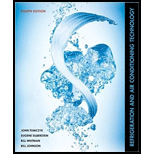
Bundle: Refrigeration And Air Conditioning Technology, 8th + Lab Manual + Lms Integrated For Mindtap Hvac-r, 4 Terms (24 Months) Printed Access Card
8th Edition
ISBN: 9781337087315
Author: John Tomczyk, Eugene Silberstein, Bill Whitman, Bill Johnson
Publisher: Cengage Learning
expand_more
expand_more
format_list_bulleted
Textbook Question
Chapter 32, Problem 7RQ
If it is expected that an oil-fired appliance will burn 850 gallons of oil per year, how big should the oil storage tank be?
A. 1500 gallons
B. 1000 gallons
C. 550 gallons
D. 275 gallons
Expert Solution & Answer
Want to see the full answer?
Check out a sample textbook solution
Students have asked these similar questions
0 = 6
a = 25
t = 3
Y
b = 30
x
Solve this problem and show all of the work
b = 25
y
t = 2
a=10
C = 25
Chapter 32 Solutions
Bundle: Refrigeration And Air Conditioning Technology, 8th + Lab Manual + Lms Integrated For Mindtap Hvac-r, 4 Terms (24 Months) Printed Access Card
Ch. 32 - How many grades of fuel oil are normally...Ch. 32 - What two elements make up fuel oil?Ch. 32 - The most common fuel oil used for residential and...Ch. 32 - As the temperature of an oil sample decreases, A....Ch. 32 - If oil is to be stored at temperatures lower than...Ch. 32 - Prob. 6RQCh. 32 - If it is expected that an oil-fired appliance will...Ch. 32 - How many pounds of oxygen are required to burn 1...Ch. 32 - Explain the concept of excess air when it is used...Ch. 32 - Before fuel oil can be burned, it must be A....
Ch. 32 - What products of combustion are produced with...Ch. 32 - When incomplete combustion occurs, what additional...Ch. 32 - The minimum nozzle pressure for residential and...Ch. 32 - Prob. 14RQCh. 32 - Describe the three functions of the oil burner...Ch. 32 - Describe three common spray patterns for an oil...Ch. 32 - The purpose of the electrodes of an oil burner is...Ch. 32 - Prob. 18RQCh. 32 - Prob. 19RQCh. 32 - List the advantages a solid-state igniter has over...Ch. 32 - Which of the following is the typical output...Ch. 32 - Prob. 22RQCh. 32 - Prob. 23RQCh. 32 - Prob. 24RQCh. 32 - Explain the difference between the hot contacts...Ch. 32 - The purpose of the cad cell in an oil burner...Ch. 32 - Explain why it is important to keep the cad cell...Ch. 32 - A one-pipe system may be used when the oil tank is...Ch. 32 - Prob. 29RQCh. 32 - Prob. 30RQCh. 32 - The oil flame must not hit the combustion chamber...Ch. 32 - Describe the purpose of the heat exchanger.Ch. 32 - When servicing an oil burner, a service technician...Ch. 32 - Describe the function of the flame-retention ring...
Knowledge Booster
Learn more about
Need a deep-dive on the concept behind this application? Look no further. Learn more about this topic, mechanical-engineering and related others by exploring similar questions and additional content below.Similar questions
- reading is 0.4 mas SHOWN. Assume h₁ = 0.4 m, h₂ = 0.5 m. (a) Do you know the specific weight of mercury? (b) Do you know the specific weight of gasoline? (c) Do you know the specific weight of oil? (a) YHg = 133,000 (b) Ygas = 6867 (c) Yoil = 8829 eTextbook and Media Part 2 N/m³ N/m³ N/m³ A+ Gasoline t +B Oil -Mercury Attempts: unlimited Did you calculate the pressure difference between two locations using the correct specific weight? Did you assume that the pressures in fluid are the same in a horizontal plane even though they are in different tubes? Are the calculated pressures in a column of fluid always higher at lower elevations? Did you account for the fact that the two horizontal tubes of the U-tube are above the ground? Concepts: The pressure in a fluid is a function of the specific weight of the fluid and the height relative to a reference. Pressure is constant in a horizontal plane of a continuous mass of fluid. (a) What is the initial pressure difference? (PA-PB) (b) What is…arrow_forwardFind the solution of the following Differential Equations 1) "-4y+3y=0 3) "+16y=0 2) y"-16y=0 4) y"-y-6y=0 5) y"+2y=0 7) y"+y=0, (#0) 9) y"-y=0, y(0) = 6, y'(0) = -4 11) y"-4y+3y=0, y(0)=-1, 13) y'(0) = -5 "+2y+2y=0 15) y"-9y=0 17) y"-4y=0 6) y"-2y+2y=0 8) "+4y+5y=0 10) y"-9y=0, y(0) = 2, y'(0) = 0 12) y"-3y+2y= 0, y(0)=-1, y'(0) = 0 14) 4y+4y+y=0 16) "+6y+12y=0 18) 4y+4y+17y=0arrow_forwardAccess Pearson Mastering Engineering Back to my courses Course Home Course Home Scoresarrow_forward
- Access Pearson Mastering Engineering Back to my courses Course Home Course Home Scores Review Next >arrow_forwardAccess Pearson Course Home Scoresarrow_forwardAccess Pearson Mastering Engineering Back to my courses Course Home Course Home Scoresarrow_forwardarrow_back_iosSEE MORE QUESTIONSarrow_forward_ios
Recommended textbooks for you
 Refrigeration and Air Conditioning Technology (Mi...Mechanical EngineeringISBN:9781305578296Author:John Tomczyk, Eugene Silberstein, Bill Whitman, Bill JohnsonPublisher:Cengage Learning
Refrigeration and Air Conditioning Technology (Mi...Mechanical EngineeringISBN:9781305578296Author:John Tomczyk, Eugene Silberstein, Bill Whitman, Bill JohnsonPublisher:Cengage Learning Welding: Principles and Applications (MindTap Cou...Mechanical EngineeringISBN:9781305494695Author:Larry JeffusPublisher:Cengage Learning
Welding: Principles and Applications (MindTap Cou...Mechanical EngineeringISBN:9781305494695Author:Larry JeffusPublisher:Cengage Learning Automotive Technology: A Systems Approach (MindTa...Mechanical EngineeringISBN:9781133612315Author:Jack Erjavec, Rob ThompsonPublisher:Cengage Learning
Automotive Technology: A Systems Approach (MindTa...Mechanical EngineeringISBN:9781133612315Author:Jack Erjavec, Rob ThompsonPublisher:Cengage Learning

Refrigeration and Air Conditioning Technology (Mi...
Mechanical Engineering
ISBN:9781305578296
Author:John Tomczyk, Eugene Silberstein, Bill Whitman, Bill Johnson
Publisher:Cengage Learning

Welding: Principles and Applications (MindTap Cou...
Mechanical Engineering
ISBN:9781305494695
Author:Larry Jeffus
Publisher:Cengage Learning

Automotive Technology: A Systems Approach (MindTa...
Mechanical Engineering
ISBN:9781133612315
Author:Jack Erjavec, Rob Thompson
Publisher:Cengage Learning
Extent of Reaction; Author: LearnChemE;https://www.youtube.com/watch?v=__stMf3OLP4;License: Standard Youtube License